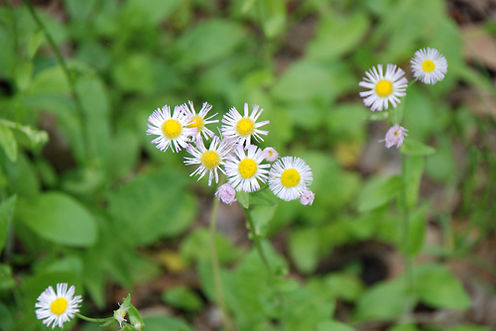common fleabane (Erigeron philadelphicus)
COMMON NAMES:
daisy fleabane
common fleabane
marsh fleabane
frost-root
skervish
poor robin’s plantain
Philadelphia daisy
Philadelphia fleabane
skevish
The genus name, Erigeron stems from the Greek eri, "early" and geron
"old man," probably because of the plant’s hairy appearance. The com-
mon name “fleabane” is from Old English and it refers to the plant’s
odor, which supposedly can repel fleas.
SCIENTIFIC SYNONYMS: There are no scientific synonyms listed
for Erigeron philadelphicus.
CONFIRMATION STATUS: Pending confirmation.
TAXONOMY: The currently accepted scientific common fleabane is
Erigeron philadelphicus L. Three varieties are recognized: 1) var. glaber,
2) var. philadelphicus, and 3) var. provancheri. The Atlas of Virginia
Flora refers to Erigeron philadelphicus variety philadelphicus as one of
four Erigeron species occurring in Facquier County.
Common fleabane can be distinguished from other fleabanes by the clasp-
ing leaves and the huge number of ray florets in a flowerhead. This plant
is usually longer-lived and prefers moister locations than the other flea-
banes. Its floral display is also showier, but shorter-lived. There is signif-
icant variation in the appearance of plants across different populations.
Similar species include: 1) Erigeron pulchellus, which has fewer ray
flowers (40-60), 2) Erigeron quercifolius, which is shorter with violet
or blue flowers, 3) Erigeron strigosus, which is an annual from 30-90cm
tall, which lacks the clasping leaves surrounding the stem. Low erigeron
(Erigeron pumilis Nutt.) is from 5-30cm tall and can have white, pink,
or bluish rays.
NATIVE STATUS: Native, United States and Canada.
GENERAL BOTANICAL CHARACTERISTICS:
Habit: This native biennial or short-lived perennial plant is up to 2½' and unbranched, except near the inflorescence. The central stem is slightly
ridged and has scattered white hairs (the leaves and stems can be sparsely
pubescent to quite hairy) and grows out of a sparse rosette of basal leaves
(4-16cm long).
Leaves: The alternate leaves are up to 3½" long and 1½" across. These
leaves clasp the stem, and become smaller and fewer as they ascend to-
ward the inflorescence. They are usually lanceolate or broadly lanceolate,
but sometimes oblanceolate, obovate, or broadly ovate. The margins may
be smooth, or there may be a few scattered teeth toward the tips of the
leaves.
Flowers: At the apex of the central stem, as well as from some of the axils
of the upper leaves, there is a single stalked inflorescence that branches
into about 3-15 daisy-like composite flowers. Each composite flower is
about ½¾" across, and consists of numerous yellow disk florets and 100-
300 surrounding white ray florets. Sometimes, the ray florets are slightly
pink or purple. There is little or no floral scent.
Fruit/Seeds: The achenes have white tufts of hair, which are carried aloft
by the wind, thereby distributing the plant.
Roots: The root system is shallow and fibrous, and may form a short cau-
dex in older plants. Colonies are often formed.
REGENERATION PROCESS: Common fleabane propogates itself by
reseeding.
HABITAT TYPES: Common fleabane grows in moist to very wet con-
ditions. Habitats include moist black soil prairies, savannas and openings
in woodlands, grassy openings, moist meadows near rivers, thickets, bor-
ders of lakes and edges of marshes, rocky bluffs, roadside ditches and low-
lying areas along railroads, abandoned fields, pastures, vacant lots, and
other waste areas and seepage areas. With the right site characteristics,
daisy fleabane will grow in virtually any moist disturbed areas. The size
of the plant varies with habitat.
SITE CHARACTERISTICS: The preference is full or partial sun, and
moist conditions. Drier locations may be tolerated; however, growth is
best in fertile, loamy soil, but gravel and clay are tolerated in moist areas
as well. Foliar disease doesn't bother this plant significantly as it tends to
die down before disease organisms have a chance to develop.
SEASONAL DEVELOPMENT: The blooming period occurs from late
spring to early summer, and lasts about 1½ months. Afterwards, this plant
tends to die down during hot, dry summer weather.
GENERAL DISTRIBUTION: Common fleabane is found throughout
most of the United States and Canadian provinces.
SKY MEADOWS DISTRIBUTION: To be determined.
IMPORTANCE AND USES: The pollen or nectar of the flowers attract
many kinds of insects, including long-tongued bees, short-tongued bees,
wasps, flies, butterflies, skippers, beetles, and plant bugs. Examples of
more frequent visitors include little carpenter bees, nomadine cuckoo
bees, green metallic bees and other halictine bees, eumenine wasps,
tachinid flies, and thick-head flies. The caterpillars of Schinia lynx (lynx
flower moth) eat the flowers and seed capsules, while Lygus lineolaris
(tarnished plant bug) sucks the plant juices. Among mammalian herbivores,
livestock, deer, and rabbits occasionally consume the leaves, stems, and
flowers.
The Cherokee and other Native American tribes used common fleabane
for a variety of medicinal purposes including epilepsy. A poultice was
made from the plant to treat headaches. The roots were either made into
tea or chewed to treat colds and coughs. The smoke from incense made
from the plant was inhaled to treat head colds. A snuff was made and
sniffed also for head colds. It was mixed with other herbs to also treat
headaches and inflam- mation of the nose and throat. The tea was used
to break fevers. The plant was boiled and mixed with tallow to make a
balm that could be spread upon sores on the skin. It was used for as an
eye medicine to treat “dimness of sight.” It was used as an astringent, a
diuretic, and as an aid for kidneys or the gout. The Cherokee and Houma
tribes boiled the roots to make a drink for “menstruation troubles” and to
induce miscarriages (to treat “suppressed menstruation”). It was also used
to treat hemorrhages and for spitting of blood. The Catawba used a drink
from the plant to treat heart trouble.

Park Activities
Calendar of Events
Volunteer Programs
Sky Meadows Park
Location
Geography
Habitats
Trails
Visiting Park
Crooked Run Valley
Special Projects

